Relic
In the context of religion, relic is a technical term describing items (such as human remains, historical artifacts, old weapons, bits of a building, etc.) that are held specifically for veneration or worship.[1] Relics can be found in most religions, though what the relics mean to the people, and how they are viewed as religious or magical items, varies greatly. They are generally most important in Christianity, Islam, and Buddhism.
| Preach to the choir Religion |
| Crux of the matter |
| Speak of the devil |
|
| An act of faith |
|
v - t - e |
“”But isn't this relic matter a little overdone? We find a piece of the true cross in every old church we go into, and some of the nails that held it together. I would not like to be positive, but I think we have seen as much as a keg of these nails. Then there is the crown of thorns; they have part of one in Sainte Chapelle, in Paris, and part of one also
in Notre Dame. And as for bones of St. Denis, I feel certain we have seen enough of them to duplicate him if necessary. |
| —The Innocents Abroad, by Mark Twain |
Typically, believers preserve relics and isolate them from non-sacred acts by the building of temples or shrines to hold the relics, housing the relics in special boxes, or insuring that only particular people can see or touch them. Buddhism, for example, has a long history of including hair, nails, teeth[2] or bits of bone in the clay used to make pottery, which is then formed for a temple and kept isolated.
Christian relics
Ark of the Covenant
Relics appear in the Old Testament. It could be argued that the Ark of the Covenant, containing the bits of the Ten Commandments, was a form of relic.
The Ethiopian Church has long claimed to possess the Ark itself, in a chapel in Aksum. It is, of course, kept conveniently hidden from any and all who might wish to see or examine it.[3] Jewish histories claim that the Ark was lost after the Bablyonians sacked King Solomon's temple in the 4th century BCE, but the Ethiopians claim that it was secreted away far south to their country for safekeeping.[4] The story isn't quite as out of left-field as it might seem. According to the Ethiopian legend, King Solomon conceived a child with the Queen of Sheba named Menelik I, from whom the entire imperial dynasty of old Ethiopia was said to have descended.[5] Thus, at some point, Menelik's people "borrowed" the Ark.
Catholic relics
In Catholic theology, relics of saints are kept "in order the better to adore Him whose martyrs they are."[6] The Catholic Church separates relics into three classes.[7][8] First-class relics are items directly involved in the life of Christ or a martyr, or physical remains of a recognized Catholic saint. Second-class relics are important items in a saint's life, such as their crucifix, Bible, rosary, etc. Third-class relics are objects which have been touched to a second-class relic.
Although disproved by carbon dating in 1988,[9] the object believed to be Christ's burial cloth still draws millions of tourists.
Alleged fragments of the True Cross appear all over the Christian world. The same can be said for the thirty-or-so supposed "Holy Nails," which are even more absurd due to the fact that Christ was crucified with, at most, four.[10] Probably the most famous instance is the Iron Crown of Lombardy, which contains a ring of iron said to be a reshaped Holy Nail.[11]
Meanwhile, an alleged Holy Lance was claimed by Charlemagne, although it was actually created in the 7th century CE. Charlemagne likely knew this relic was a fake, however his claim as the successor to the Roman Emperors needed to be able to compete with that of the Byzantine emperor, who owned a large number of Christ's relics.[12] The "Lance" became a part of the Hapsburg Crown Jewels and is now in Vienna.
Other relics claimed to be from Christ's life abound. His sweaty, stinky sandals are said to be in Germany,[13] while His robe is either there or in France,[14] while a shred of His blood-stained shirt is in Belgium.[15] Let's not even get started on his Holy Foreskin.
Relics from saints, on the other hand, are too plentiful to be counted without risking extreme boredom. In the New Testament, certain relics that had been touched by Saint Paul were said to have the power to heal the sick:
“”And God wrought by the hand of Paul more than common miracles. So that even there were brought from his body to the sick, handkerchiefs and aprons: and the diseases departed from them: and the wicked spirits went out of them. |
| —Acts 19:11-12 |
St Teilo, a Welsh monk and bishop, is said to have miraculously had three dead bodies (through some kind of duplication process), so three churches could all have the full set of relics.[16] The alternative, they they don't all have genuine Teilo, is so horrible that surely God would never allow it.
Relics were common throughout the early Church, so much so that during the Council of Nicaea, it was a requirement that each altar have relics built into it.[17]
This explains the prevalent and ongoing Roman Catholic practice of chopping their most revered religious figures into tiny bits after death and distributing fragments of their remains to congregations around the world, rather than letting them rest in peace. Throughout the Catholic world, relics are present in the Churches, altars, and other holy sites. Protestant religions are far less likely to maintain relics, especially human remains. John Calvin was a major opponent of keeping relics, as was Martin Luther.[18] This was a major contributing factor in the Protestant Reformation.
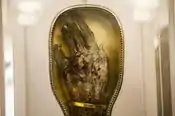 Arm of St. Francis Xavier.
Arm of St. Francis Xavier. Skull of St. Valentine.
Skull of St. Valentine. Pope Francis and the Blood of St. Gennaro.
Pope Francis and the Blood of St. Gennaro.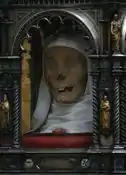 Head of St. Catherine.
Head of St. Catherine. Reliquary containing the hand of St. Teresa. The Infinity Gauntlet in real life![19]
Reliquary containing the hand of St. Teresa. The Infinity Gauntlet in real life![19]
Eastern Orthodox relics
The veneration of relics is equally important in Eastern Orthodoxy. The religion considers the physical form, and not just the soul is transformed by holiness; thus relics are revered as "temples of the Holy Spirit."[20] One of the great cultural tensions that exists in the Orthodox Church is the lack of emphasis placed by American Orthodox followers on the importance of relics.[21] Another Orthodox belief is the concept of "incorruptibility", the idea that true saintly relics do not decompose normally after death.[22] Evidence of "incorruptibility" includes intact hair and fingernails, visible eyebrows and eyelids, and having the hands still holding the cross with which the individual was buried.[23]
Eastern Orthodoxy does not enforce the strict classification system of the Catholics, but it does recognize relics as being related to the life of Jesus Christ. For instance, one of the competitors to the claim of being the true Holy Lance is in Armenia.[24]
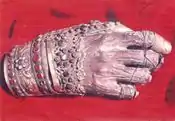 St. John Chrysostom’s incorruptible hand.
St. John Chrysostom’s incorruptible hand. Relic of St. Innocent in Russia.
Relic of St. Innocent in Russia.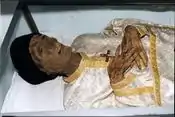 Relic of Fr. Ilie in Romania.
Relic of Fr. Ilie in Romania.
Islamic relics
With the outsized influence of reformist Islamic movements like Wahhabism and Salafism, which reject the veneration of relics, there is increasingly the erroneous belief that Islam as a whole has a negligible tradition of keeping relics.[25] Historically, however, classical Islamic thinkers posed many justifications for the veneration of relics and Islamic relics were and are highly prized.[26] Perhaps most notable are the various relics collected by the Ottoman Turks which are claimed to be from the life and body of the Prophet Muhammad.[27] The Turkish government still cares for and maintains the relics, among which are allegedly Muhammad's beard, tooth, sword, and writings.[28]
Despite their Wahhabist beliefs, even Saudi Arabia has reluctantly permitted the veneration of at least one relic at Mecca. Near the Kaaba is the "Maqam Ibrahim" or "Station of Abraham", a rock with what are allegedly the prophet Abraham's footprints.[29] Muslims make prayers there during their final circuit around the Great Mosque of Mecca. Abraham's footprints are also strangely shaped and much larger than a normal human being's feet. The Kaaba and its Black Stone are also arguably relics as well.
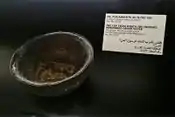 "The cup from which Muhammad drank water." Wow!
"The cup from which Muhammad drank water." Wow! A strand of Muhammad's hair. Let's hope it came from his head.
A strand of Muhammad's hair. Let's hope it came from his head.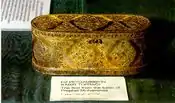 Soil from Muhammad's tomb.
Soil from Muhammad's tomb. Footprints of Abraham at the Great Mosque of Mecca.
Footprints of Abraham at the Great Mosque of Mecca.
Buddhist relics
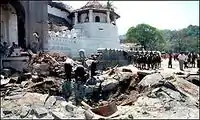
Buddhist relics are referred to under the catch-all term of Śarīra. Buddhists do not worship these relics, but do preserve them for veneration under the belief that relics can provide a connection to old masters of the religion, including Gautama Buddha himself.[30] Buddhist tradition holds that Buddha was cremated after his death, and his ashes divided among his followers; various sites and countries around the world claim to possess these relics today.[31] Fragments of Buddha's teeth and strands of his hair are also alleged to still be around. In Buddhist cultures, destruction of a relic was historically considered a crime on par with the murder of a human being.[31]
One of the holiest Buddhist temples is in Sri Lanka and allegedly contains one of Buddha's teeth. The Tamil Tigers attacked it with a truck bomb in 1998, killing 11 people but failing to destroy the tooth.[32] The attack shocked the majority Buddhist nation, and the New York Times quoted a man as saying, "You terrorists, kill us, eat us, but don't attack our shrines where Buddha lives."[32]
One of the unique versions of a Buddhist relic is the sarira where the above word is derived. These are believed to be pearl-like colored stones allegedly left behind when a great Buddhist monk is cremated.[33] There's a whole classification system and mythology surrounding them. The pearls are said to grow within the human body, with yellowish ones coming from the liver, whitish ones coming from the head, and so on.[33] It is most likely that sarira form naturally during the cremation process. Under certain conditions, human bones can form a variety of crystalline structures through the application of heat.[34]
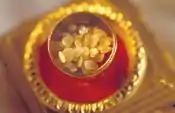 Sarira on display.
Sarira on display. Relic alleged to be Buddha's tooth.
Relic alleged to be Buddha's tooth. A "healing" ritual involving sarira.
A "healing" ritual involving sarira.
Marxist-Leninist relics
Although this authoritarian brand of communism was and is staunchly atheist, observers couldn't help but notice their tendency to preserve the corpses of their former leaders and place them in "secular cathedrals".[35] Instead of relying on religious dogma for preservation, though, the communists used a variety of chemical preservation methods and even allegedly stuffed some electric environmental control devices into the corpses cavities.[36] Ilya Zbarsky, who was a member of Lenin's embalming maintenance team at the Research Institute for Biological Structures in Moscow, revealed to the BBC how Russia continues to maintain Vladimir Lenin's corpse: "Twice a week, we would soak the face and the hands with a special solution. We could also improve some minor defects. Once a year the mausoleum was closed and the body was immersed in a bath with this solution."[36] The Russians got so good at body preservation that the Vietnamese government would fly Ho Chi Minh's corpse out to Moscow for the same treatment. This is, as you might guess, a much more intensive process than the regular embalming you'd see for a funeral. Embalming is temporary and only meant to last until the casket closes, while communist corpse preservation is meant to last indefinitely and keep the corpse viewable to the public.
Vladimir Putin has publicly compared Lenin's corpse to a Christian relic at least once before.[37] Even after the downfall of the Soviet Union, Russian guards are still determined to force guests to seem at least outwardly deferential.[38] Still, most visitors to the dead commie these days are morbidly curious or history buffs rather than genuine Lenin devotees.
Ho Chi Minh's corpse is among the most controversial. It's rumored that the corpse is a fake, and it doesn't help that the Vietnamese honor guards use dim lighting and a constantly moving line to ensure that photos of it are incredibly difficult to get.[39] The Vietnamese remain among the most zealous in guarding their dead former leader. It's under 24-hour guard by riflemen carefully selected for their patriotism; the site is usually busy with Vietnamese civilians making pilgrimages there to honor their country's founding father.[40]
 Lenin's corpse in the Red Square's Lenin Mausoleum.
Lenin's corpse in the Red Square's Lenin Mausoleum. Mao Zedong at the Mausoleum of Mao Zedong in Beijing.
Mao Zedong at the Mausoleum of Mao Zedong in Beijing. Kim Jong Il in the Kumsusan Memorial Palace.
Kim Jong Il in the Kumsusan Memorial Palace. Illicit photo of Ho Chi Minh in Hanoi.
Illicit photo of Ho Chi Minh in Hanoi.
See also
External link
- For Sale: The Hair of the Virgin Mary: What does a supposedly secular world want with the creepy (and probably fake) remains of medieval saints? by Mattia Ferraresi (June 15, 2020) The New York Times
References
- See the Wikipedia article on Relic.
- The Buddha Tooth Relic Temple of Singapore
- Keepers of the Lost Ark? Raffaele, Paul. Smithsonian Magazine. December 2007.
- Is the Ark of the Covenant in Ethiopia? Daily Beast.
- How the Ark of the Covenant got to Ethiopia Downer, Lesley. Japan Times.
- Jerome, Ad Riparium, i, P.L., XXII, 907.
- I Made a Third-Class Relic of St. Dominic—Here’s How McAfee, Shaun. National Catholic Register.
- Types of Holy Relics
- Shroud of Turin "TIME Magazine
- Holy Nails Catholic Encyclopedia.
- See the Wikipedia article on Iron Crown of Lombardy.
- The Holy Lance Kunsthistorisches Museum Vienna.
- Sandals of Jesus Christ
- Textile Relics Associated with Jesus
- The Story Behind Bruges’ Basilica of the Holy Blood
- See the Wikipedia article on Saint Teilo.
- Altar, Altar cavity The Catholic Encyclopedia (1907)
- A Treatise about relics, John Calvin
- Thanos’ Infinity Gauntlet looks eerily similar to a Catholic relic
- The Place of Holy Relics in the Orthodox Church St. Justin Popovich. Orthodox Christian Information Center.
- Why Relics? St. Innocent Orthodox Church.
- Relics and Mummies from Orthodox Tradition, Vol. XII, No. 4, pp. 35-36.
- ON THE LIFE, GLORIFICATION, AND INCORRUPT RELICS OF ST. MARDARIJE OF LIBERTYVILLE
- The Holy Lance in Armenian Tradition and Legend The Armenian Church, Diocese of America.
- Josef W. Meri, “Relics of Piety and Power in Medieval Islam,” Past and Present 103.5, in Relics and Remains (Oxford: Oxford University Press, 2010), p. 97.
- Josef W. Meri, “Relics of Piety and Power in Medieval Islam,” Past and Present 103.5, in Relics and Remains (Oxford: Oxford University Press, 2010), p. 98
- https://topkapisarayi.gov.tr/en/content/pavilion-holy-mantle-and-holy-relics Pavilion of the Holy Mantle and Holy Relics] Topkapi Palace, Turkey.
- Islam's sacred relics protected by Turkish state, foundations Daily Sabah.
- 9 Things to Know About Maqam Ibrahim. About Islam.
- Buddhist relics on display in Sedona, their last appearance on world tour Ron Dungan, AZ Central.
- Relics of the Buddha
- 11 Killed in Truck Bombing At Sri Lanka Buddhist Site New York Times. JAN. 26, 1998.
- Sarira: Buddhist Human Pearls Kevin Lo, Atlas Obscura.
- "Scanning electron microscope observations of heat-treated human bone". Forensic Sci. Int. 74 (1–2): 29–45. June 1995. doi:10.1016/0379-0738(95)01735-2. PMID 7665130.
- Ryan, Karen L. (2009), Stalin in Russian Satire, 1917–1991, Univ of Wisconsin Press, pp. 157–159, ISBN 0299234436
- Who, What, Why: How do you embalm a leader? BBC News.
- Vladimir Putin compares Lenin to holy Christian relics. The Telegraph.
- Red Square rendezvous: Visiting Lenin's body in Moscow. CNN.
- Ho Chi Minh Mausoleum. Atlas Obscura.
- Half a century after Ho Chi Minh’s death, his embalmed body is guarded around the clock. South China Morning Post.